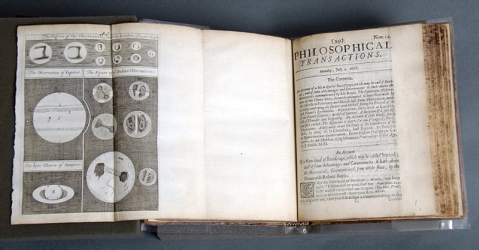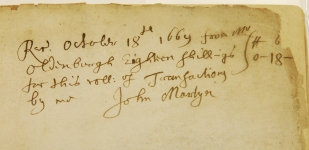Scientific Instrument Society 25th Anniversary Exhibition
Navigation:
<< First | < Previous | Next > | Last >>
40 Philosophical Transactions of the Royal Society
Of all the items in my collection, this is my favourite. Turning its pages is like being in direct physical contact with the very mainstream of European cultural history. Names like Isaac Newton’s great rival, Robert Hooke, or that of Christian Huygens, the inventor of the pendulum clock (amongst other things), leap off its pages.
This volume spans the very first two years of the Royal Society’s in-house journal, the Philosophical Transactions, and contains 22 of the monthly issues. Spanning the years 1665-6, even its publication history is extraordinary, encompassing as it does, both the Plague Year of 1665 and the Great Fire of London. Thus, although publication of the first few issues commenced in the heart of Old London town, near St. Paul’s, it was forced to move to Oxford to escape the Plague. Then, no sooner had the Plague been subdued by a particularly harsh winter, making it safe to return to London, than publication was again interrupted by the Great Fire. When its publication resumed, the remaining numbers were printed no longer in St. Paul’s churchyard, but just outside Temple Bar on the Strand, beyond the area destroyed in the Fire.
The contents are no less rich. An account of the discovery of Jupiter’s Great Red Spot or discussions of who grinds the best telescope lenses in Europe mingle alongside reports of monstrous two-headed calves and of people struck by lightning. Practical discussions of how to establish a native British silk production facility find their place too. Add to all that the fact that this particular volume is inscribed from the printer to Henry Oldenburg, the very first Secretary of the Royal Society, who left all his papers at his death to Robert Hooke, the latter of whom therefore very probably owned this particular volume after Oldenburg, and it is not hard to see why my hands were trembling when I was first given the opportunity to acquire it.
Collection: Marcus Cavalier, Oxfordshire
Founded in 1660, the Royal Society was the first British institution to embody the new science of the 17th century. The opening of this museum building in 1683 as a site for a chemical laboratory, teaching rooms and Elias Ashmole’s collection of ‘natural and artificial rarities’ was part of the same scientific movement.
The volume is open at the beginning of issue 14 which advertises new English and Italian observations of the planets Mars, Jupiter and Saturn illustrated on the folding plate.
The ownership of the volume is apparent from a manuscript note on a flyleaf. This is a receipt signed by the Royal Society’s printer: “Rec. October 18th 1669 from Mr Oldenburgh Eighteen shillings for this voll: of Transactions by me John Martyn”. Perhaps Oldenburg was documenting his costs in completing a set of early numbers for the Society. This was the first year in which he was actually paid for his work as their secretary.
S.J.


